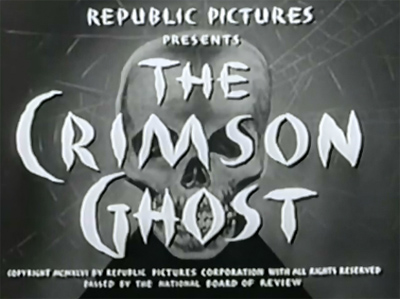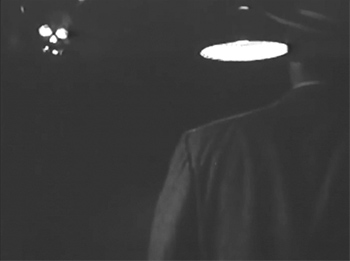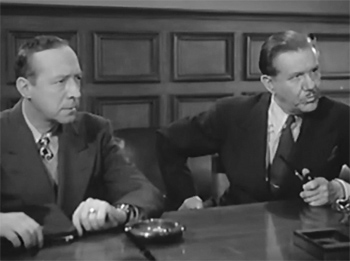
12 Chapters, Republic 1946. Starring Charles Quigley, Linda Stirling, Clayton Moore, Sam Flint, Joe Forte, Forrest Taylor, Emmett Vogan, Kenne Duncan, and I. Stanford Jolley as the voice of the Crimson Ghost.
University scientist Professor Chambers (Kenne Duncan) has succeeded in perfecting his Cyclotrode, a powerful atomic weapon that can be used to destroy any electrically-powered device. A mysterious master criminal who calls himself The Crimson Ghost promptly sets out to gain control of this valuable new invention, with the assistance of a gang of thugs and a sinister array of scientific gadgets. Chambers’ colleague Duncan Richards (Charles Quigley), a noted criminologist, tirelessly battles the Ghost and his followers, aided by university secretary Diana Farnsworth (Linda Stirling) and warmly supported by a quartet of university scientists–one of whom, however, is secretly the Crimson Ghost himself.
The plot of Crimson Ghost is, in outline, unremarkable, centering as it does around a prolonged and repetitive duel over a scientific MacGuffin and the money and material needed to operate it. The Ghost’s motives for trying to seize said MacGuffin are also rather poorly defined, by Republic standards; in the first chapter, the villain hints that he intends to use the Cyclotrode to blackmail the power and transportation industries–but then ceases to mention his plans for the gadget, treating Cyclotrode ownership as an end in itself until the eleventh chapter–when he starts trying to sell it to a foreign agent, instead of making power-mad use of it himself. However, the Ghost and his followers do operate the Cyclotrode quite frequently throughout the serial–using it to commit robberies, wreck cars, and crash planes; by allowing their MacGuffin to play such a prominent part in the action, writers Albert DeMond, Basil Dickey, Jesse Duffy, and Sol Shor make the fight over the Cyclotrode more interesting than it would have been had the device remained in a merely conceptual stage till the concluding chapters (like the rocketship in Purple Monster Strikes or the remote-control machine in Manhunt of Mystery Island).

Above: Kenne Duncan displays the complete Cyclotrode (one of the best products of Republic’s prop department, by the way) for Forrest Taylor (far left), Linda Stirling, and Sam Flint (back to camera).
The writers incorporate many other neat science-fiction gadgets into the narrative–a death ray, a lock-melting device, a super-powered stethoscope, a record and a cigarette box that emit knockout gas, and, especially, the Ghost’s genuinely scary “control collars”–devices that force people to do the villain’s bidding against their will, and kill the wearer (by exploding their throats) if they’re removed by anyone but the Ghost. More than one character meets their end in this grisly fashion–which gives an extremely high level of suspense to the sequence in which the heroine is outfitted with one of the collars, and to the hero’s subsequent attempt to remove it without killing her. The control collars and the other gadgetry help to keep the serial’s narrative lively despite its repetitive structure; the way in which the writers alternate between the Ghost’s pursuit of Cyclotrode-related equipment and Duncan Richards’ often elaborate attempts to trap the villain also helps to minimize repetitiveness.


Above: Linda Stirling and Charles Quigley during the tense control-collar-removal sequence.
Crimson Ghost receives another substantial boost from its director William Witney–who, in his only post-war serial assignment, seems to have conspired with cinematographer Bud Thackery and co-director Fred Brannon to give Ghost some of the stylishly shadowy visuals that marked Witney’s pre-war “mad science” serials like Mysterious Doctor Satan; the Crimson Ghost’s dramatic entrance at the beginning of the first episode and the darkened-cellar sequence in Chapter Four are particularly striking. I suspect that the notion of having a Doberman pinscher play a key role in the climactic episode originated with Witney, too–since such animal scenes would become a hallmark of his later Roy Rogers B-westerns for Republic. The use of the dog helps to redeem a closing chapter that would otherwise have come off as somewhat lackluster; having a technological wizard like the Ghost brought down by an unsophisticated canine lends both novelty and an enjoyable sense of poetic irony to the finale.


Above left: Rex Lease (in shirtsleeves) and Clayton Moore turn to see the Ghost making his first entrance. Above right: Charles Quigley pursues Clayton Moore through a cellar passage.
Witney’s directorial hand is also very much in evidence in Ghost’s fight scenes, which combine the set-smashing brawling that dominated most of Republic’s post-1943 serials with the some of the sprightly acrobatics featured in Witney (and John English’s) outings from earlier years. Dale Van Sickel, who doubles hero Charles Quigley in most of the action scenes, does an outstanding job of imitating Witney’s favorite pre-war stuntman David Sharpe–jumping over tables, leaping from heights, and running up walls with a nimbleness remarkable in a man of his size. Tom Steele doubles action heavy Clayton Moore; Joe and Bill Yrigoyen, Fred Graham, Duke Taylor, Bud Wolfe, Johnny Daheim, Ted Mapes, and Eddie Parker are among the other participants in Ghost’s brawls. The dynamic battle in the University board-room in Chapter One, the fight in the warehouse office later in the same episode, and the terrific fight in Chapters Six and Seven–which has Steele, Joe Yrigoyen (doubling the hero this time) and Van Sickel (playing a heavy) using a parked truck like a jungle gym–are especial highlights.


Above left: Dale Van Sickel (literally) bounces off the wall as he fights Tom Steele in Chapter One. Above right: Steele and Van Sickel take a fall during the truck fight in Chapter Six.
Other standouts include the lab fights in Chapter Two and Seven, the apartment fights in Chapters Three and Eleven, the Chapter Five radio-shop fight, the cliff-edge fight between Van Sickel and Loren Riebe in Chapter Six, the Chapter Nine cave fight, and the Chapter Ten warehouse fight between Van Sickel and Ken Terrell. The villains’ attempt to run the hero over with a car in Chapter Four (which has Van Sickel springing up a rock face to escape) and the lengthy outdoor shootout in Chapter Ten are also excellent; both sequences make particularly good use of the scenery of Iverson’s Ranch; the same backdrop also figures in the cliff-edge fight and in the Chapter Seven foot chase that has Clayton Moore pursuing Linda Stirling. Stuntwoman Polly Burson doubles Linda Stirling for the dangerous-looking fall that concludes the latter sequence (and for a few other risky pieces of stuntwork).


Above left: Clayton Moore takes an impressive-looking punch from Charles Quigley (both actors being undoubled for the close-up) during the Chapter Two lab fight. Above right: Quigley (silhouetted against the Iverson’s skyline) and Moore in the Chapter Ten shootout.
Several of the cliffhangers in Crimson Ghost (like the car-plane collision in Chapter Four or the truck crash in Chapter Ten) are derived from earlier Republic serials; the serial’s new endings are quite plentiful, however–and are quite well-done. The endings to Chapter Two (the hero about to walk into the path of a death ray), Chapter Four (the hero trapped in a gas-filled room as the villain laughs maniacally over the radio), and Chapter Eight (the heroine apparently dying during the control-collar removal process) are particularly good–directed and edited in tensely suspenseful fashion, and fully as exciting as Republic’s more typical explosive cliffhangers. Chapter Seven’s cliffhanger, which has the mind-controlled heroine knocking the hero into a high-voltage generator, is very memorable as well; the fall from the telephone-wire in Chapter Three and the impressive laboratory explosion that concludes Chapter Nine are less unusual, but are still first-rate.


Above left: The Ghost informs Charles Quigley–via a glowing skull-shaped radio–that his “life is forfeit” at the end of Chapter Four. Above right: The Chapter Nine lab fire/explosion.
Charles Quigley, who made an excellent lead in one of director Witney’s best 1930s outings (Daredevils of the Red Circle) does a similarly strong job here; he gives Duncan Richards a self-possessed and rather crafty manner befitting a supposed master criminologist, but still displays plenty of eager energy and wry good-humor–particularly when delivering various quips at the heavies’ expense (“All right, Ashe, turn off that Cyclotrode; you’ve played with it long enough”). Linda Stirling, in her last really prominent chapterplay role, makes an enormously appealing heroine–earnestly but enthusiastically discussing strategies with Quigley, resolutely but cheerfully accompanying him into danger, and looking perfectly lovely all the while. She also conveys convincing disorientation and pained perplexity when her character is temporarily under the influence of the control collar, making her plight seem compellingly real.

Above: Linda Stirling and Charles Quigley.
I. Stanford Jolley rightly receives co-star billing for his voicing of the Crimson Ghost (he also wore the Ghost’s robe and mask, except when the character becomes involved in fight scenes). He delivers his lines in a smooth, gloating tone that always seems to carry an underlying note of insanity–an impression reinforced by his evil chuckles, his unhinged laugh during the aforementioned Chapter Four cliffhanger, and the cold fierceness with which he threatens his opponents or gives orders to his mind-controlled minions. Jolley’s sinister vocals are complemented by the Ghost’s creepy-looking skull mask–which, accompanied by a cowled robe, gives the villain a visual presence as strong as his vocal one. Clayton Moore plays very successfully against type as the Ghost’s chief henchman Ashe; his heroic appearance notwithstanding, he makes his character just as formidably nasty as a more naturally thuggish actor like Anthony Warde could have–sneering coldly or grinning evilly when plotting with his boss, and glaring murderously when confronting the good guys.

Above: Clayton Moore and the Crimson Ghost.
The pool of Crimson Ghost suspects is made up of a quartet of reliable character actors–Sam Flint (genteelly avuncular), Joseph Forte (affably mild-mannered), Forrest Taylor (dignified but sly), and Emmett Vogan (brusque and self-important). All four make the most of their appearances, although the short running time of the serial’s episodes (the standard post-war 13-minute length) deprives them of the scope for red-herring behavior that the similar group in Adventures of Captain Marvel enjoyed. Kenne Duncan has an unusually sympathetic (even heroic) role as Professor Chambers, but plays it well–giving the beleaguered scientist both shrewdness and a dogged courage (his first-chapter defiance of Clayton Moore’s Ashe is particularly good).


Above, left to right across both pictures: Joseph Forte, Sam Flint, Emmett Vogan, and Forrest Taylor.
The stocky, folksy-sounding Rex Lease (a veteran B-western actor) seems rather miscast as the Crimson Ghost’s lab assistant, but has very little to do in any case; Stanley Price is enjoyably hammy as the haughty, irritable, and distinctly Russian-sounding foreign agent who strikes a deal with the Ghost in the last two chapters. I. Stanford Jolley oddly takes a brief second role as a control-collared doctor in the Ghost’s service; he talks in a more restrained manner than when behind the Ghost’s mask, but it’s still a little peculiar to hear Ghost Jolley ordering Doctor Jolley to “kill Richards” (via the control collar’s radio). All the stuntmen play one or more henchmen–save for Johnny Daheim and Ted Mapes, who pop up as university security guards. Wheaton Chambers is a cautious storage-vault manager, Rose Plumer a shifty charwoman, and Rod Bacon (former co-hero of The Masked Marvel) and Bob Wilke a pair of ill-fated armored-car guards.
Despite the ordinariness (and the haziness) of its central plotline, The Crimson Ghost ultimately succeeds on the strength of its excellent mounting. Its direction, action scenes, cliffhangers, performances, colorful collection of science-fiction props, and its memorable titular villain make it thoroughly entertaining. It’s one of the only post-war Republic serials to enjoy nearly the same measure of fame and popularity as the studio’s Golden Age classics–appropriately so, since it represents the final contribution to serial-making by William Witney, a prominent architect of that Golden Age.

One of my favorites that i’ve watched many times. As stated in this review Crimson Ghost is like another excellent serial,Mysterious Dr. Satan, full of atmosphere.I have both in my collection. An occasional viewer will not notice the stock footage from other serials. This footage causes no problems since it is expertly edited in.I tend to disagree with some fans about the abilities of lead Charles Quigley.He fills the bill in the physical scenes but in my opinion lacks in the acting department. I felt the same in another serial,Daredevils of the Red Circle. This might be considered nit picking so i wont belabor the point.In all other respects Ghost is an excellent chapterplay and rates **** out of *****.Well worth repeated viewing.
You wrote that Bud Geary wore the costume of The Crimson Ghost is some of the action scenes, but I find that hard to believe, seeing it was filmed between March 28 and April 24, 1946, and Geary died in a auto accident on February 22, over a month before filming started.
Thank you very much for that correction, Ron; my error has been removed from the article. I was hesitant to put that reference to Geary in, seeing as I originally got it from the highly unreliable Harmon and Glut serial book; it’s been repeated everywhere since, but that’s no excuse for me.
Your provision of the above dates also makes me more certain that I. Stanford Jolley was telling the truth when he claimed in a 1973 interview for the Film Collector’s Registry (published in 1974) that it was “me all the time under the robes and mask of the Crimson Ghost.” I’d always been a little dubious about Jolley’s claim, since he also said in the interview that the mask was “specially made for this film by the Westmore make-up people” and that it entailed a “two hour session in the makeup chair” for him. I find it somewhat hard to believe that the mask could have been specially constructed around Jolley’s face, since one stuntman or another would have worn it in the Ghost’s fights–and since Clayton Moore wears it at one point in the serial as well. Also, as far as I know, the Westmore people did no work for Republic. However, while Jolley may have misremembered a few details (or fabricated a few, in actorly tradition), your discrediting of the Geary legend leaves us with no reason not to believe him essentially correct.
Great review. Has always been one of my favorites. Quigley? I see him as a solid second-string serial leading man. He gets the job done w/o giving the serial a big lift by his presence. He was very lucky in getting into such good ones at Republic. Quigley is okay in this one, and not a weak link, but his three co-stars steal the show. Linda Stirling is really something, even in these non-glamorous serial roles. (I just watched her in a glamor role in The Madonna’s Secret, and Ava and Rita, move over) The Crimson Ghost is my all-time favorite villain, and Clayton Moore the all-time best henchman. My one criticism of this one is the ending, which places the solution to the boring mystery above a “the villain gets his” climax. I think the Ghost deserved a spectacular demise like Dr. Satan, 39013, Don Del Oro, The Black Widow, The Lightning, and Dr. Vulcan. Still, in the top ten for me. ***** out of *****
Regarding Bud Geary: I’d never put the two dates together; the filming dates and his death. So I guess we go with John Ford on this – “When the legend becomes fact, print the legend”.
I have looked more than a dozen times over 10 years for a Crimson Ghost mask…..to no avail. I MEAN A GOOD ONE!! How can it be so difficult to reproduce this item given the interest in the character and today’s technology. 3-D printers? I would pay a $100 for an accurate representation.
To me this serial represents a missed opportunity for Republic. Clayton Moore is in the cast. So what does Republic do? They cast him as a henchman while the less charismatic Charles Quigley is given the lead role. Crimson Ghost would have been greatly improved, imo, if those two had traded roles.
A more than fitting conclusion to William Witney’s serial career, and one of my all-time favorites. The Ghost is an absolutely terrific villain and his presence alone more than makes up for the somewhat lackluster storyline. Jolley’s voice adds so much to the character, and makes him seem even more sinister and threatening. Clayton Moore is first-rate as the henchman Ashe, and it was fun to see Kenne Duncan in an atypical “good guy” part. I thought Charles Quigley did a more than satisfactory job as the hero. He’s definitely not the most commanding actor, but he filled the bill well enough, and managed to occasionally inject some humor into the proceedings. As for Linda Stirling, she didn’t have very much to do, other than be supportive of Quigley, but she certainly looked fantastic in those hot 1940’s slacks!
I’ve wanted to see this one ever since I saw stills of the Ghost in the mid sixties. Finally got the opportunity recently and I throughly enjoyed it. While the story was lacking in urgency and characterization is basically zilch, the film contains some of the finest most exciting fight scenes I’ve ever seen. That’s the strength of the serial.
I do agree with Mr. Harris’s opinion that Quigley and Moore should have switched roles. Moore is sufficiently ruthless but he just looks too heroic. Quigley seems more husky than he was in Daredevils of the Red Circle and he looks great in the action scenes but he came across a little too brusque for a hero. I don’t know who wore the mask and robes of the Ghost, but he’s the most visually arresting villain in any serial I’ve ever seen. And Lovely Linda certainly rocks those slacks!